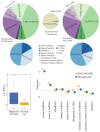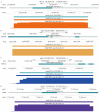Evidence for Existence of Multiple Functional Human Small RNAs Derived from Transcripts of Protein-Coding Genes
- PMID: 36835575
- PMCID: PMC9959880
- DOI: 10.3390/ijms24044163
Evidence for Existence of Multiple Functional Human Small RNAs Derived from Transcripts of Protein-Coding Genes
Abstract
The human genome encodes a multitude of different noncoding transcripts that have been traditionally separated on the basis of their lengths into long (>200 nt) or small (<200 nt) noncoding RNAs. The functions, mechanisms of action, and biological relevance of the vast majority of both long and short noncoding transcripts remain unknown. However, according to the functional understanding of the known classes of long and small noncoding RNAs (sncRNAs) that have been shown to play crucial roles in multiple biological processes, it is generally assumed that many unannotated long and small transcripts participate in important cellular functions as well. Nevertheless, direct evidence of functionality is lacking for most noncoding transcripts, especially for sncRNAs that are often dismissed as stable degradation products of longer RNAs. Here, we developed a high-throughput assay to test the functionality of sncRNAs by overexpressing them in human cells. Surprisingly, we found that a significant fraction (>40%) of unannotated sncRNAs appear to have biological relevance. Furthermore, contrary to the expectation, the potentially functional transcripts are not highly abundant and can be derived from protein-coding mRNAs. These results strongly suggest that the small noncoding transcriptome can harbor multiple functional transcripts that warrant future studies.
Keywords: RNA dark matter; high-throughput phenotypic assay; noncoding RNA; short RNA; small RNA.
Conflict of interest statement
The authors declare no conflict of interest.
Figures







Similar articles
-
The human genome encodes a multitude of novel miRNAs.Nucleic Acids Res. 2025 Feb 8;53(4):gkaf070. doi: 10.1093/nar/gkaf070. Nucleic Acids Res. 2025. PMID: 39964476 Free PMC article.
-
Simultaneous sequencing of coding and noncoding RNA reveals a human transcriptome dominated by a small number of highly expressed noncoding genes.RNA. 2018 Jul;24(7):950-965. doi: 10.1261/rna.064493.117. Epub 2018 Apr 27. RNA. 2018. PMID: 29703781 Free PMC article.
-
Regulatory non-coding RNAs: revolutionizing the RNA world.Mol Biol Rep. 2014 Jun;41(6):3915-23. doi: 10.1007/s11033-014-3259-6. Epub 2014 Feb 19. Mol Biol Rep. 2014. PMID: 24549720 Review.
-
The coding and noncoding transcriptome of Neurospora crassa.BMC Genomics. 2017 Dec 19;18(1):978. doi: 10.1186/s12864-017-4360-8. BMC Genomics. 2017. PMID: 29258423 Free PMC article.
-
Interactions between short and long noncoding RNAs.FEBS Lett. 2018 Sep;592(17):2874-2883. doi: 10.1002/1873-3468.13085. Epub 2018 May 23. FEBS Lett. 2018. PMID: 29749606 Review.
Cited by
-
Human Breast Milk miRNAs: Their Diversity and Potential for Preventive Strategies in Nutritional Therapy.Int J Mol Sci. 2023 Nov 9;24(22):16106. doi: 10.3390/ijms242216106. Int J Mol Sci. 2023. PMID: 38003296 Free PMC article. Review.
-
The human genome encodes a multitude of novel miRNAs.Nucleic Acids Res. 2025 Feb 8;53(4):gkaf070. doi: 10.1093/nar/gkaf070. Nucleic Acids Res. 2025. PMID: 39964476 Free PMC article.
References
MeSH terms
Substances
Grants and funding
LinkOut - more resources
Full Text Sources
Molecular Biology Databases
Research Materials

